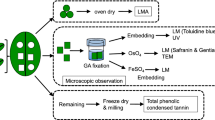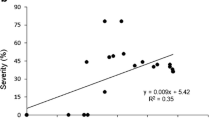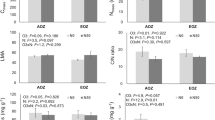Abstract
Tannin and total phenolic levels in the foliage of loblolly pine (Pinus taeda L.) were examined in order to evaluate the effect of atmospheric pollution on secondary plant metabolism. The trees were exposed to four ozone concentrations and three levels of simulated acid rain. Tannin concentration (quantity per gram) and content (quantity per fascicle) were increased in foliage exposed to high concentrations of ozone in both ozone-sensitive and ozone-tolerant families. No effect of acid rain on tannins was observed. Neither total phenolic concentration nor content was significantly affected by any treatment, indicating that the ozone-related increase in foliar tannins was due to changes in allocation within the phenolic group rather than to increases in total phenolics. The change in allocation of resources in the production of secondary metabolites may have implications in herbivore defense, as well as for the overall energy balance of the plant.
Similar content being viewed by others
References
Bryant, J.P., Chapin, F.S., III, andKlein, D.R. 1983. Carbon/nutrient balance of boreal plants in relation to vertebrate herbivory.Oikos 40:357–368.
Chappelka, A.H., Kraemer, M.E., Mebrahtu, T., Rangappa, M., andBenepal, P.S. 1988. Effects of ozone on soybean resistance to the Mexican bean beetle (Epilachna varivestis Mulsant).Environ. Exp. Bot. 28:53–60.
Chappelka, A.H., Kush, J.S., Meldahl, R.S., andLockaby, B.G. 1990a. An ozone-low temperature interaction in loblolly pine (Pinus taeda L.).N. Phytol. 114:721–726.
Chappelka, A.H.,Lockaby, B.G.,Mitchell, R.J.,Meldahl, R.S.,Kush, J.S., andJordan, D.N. 1990b. Growth and physiological responses of loblolly pine exposed to ozone and simulated acid rain in the fieldin Proceedings of Air and Waste Management Association. June 24–29, 1990, Pittsburgh, Pennsylvania. 90-187.5.
Cogbill, C.V., andLikens, G.E. 1974. Acid precipitation in the northeastern United States.Water Resour. Res. 10:1133–1137.
Coley, P.D. 1986. Costs and benefits of defense by tannins in a neotropical tree.Oecologia. 70:238–241.
Coley, P.D., Byrant, J.P., andChapin, F.S., III. 1985. Resource availability and plant antiherbivore defense.Science. 230:895–899.
Gershenzon, J. 1984. Changes in the levels of plant secondary metabolites under water and nutrient stress.Recent Adv. Phytochem. 18:273–320.
Goodwin, T.W., andMercer, E.I. 1983. Plant phenolics, pp. 567–626,in Introduction to Plant Biochemistry, 2nd ed. Pergamon Press, Oxford.
Hagerman, A.E. 1987. Radial diffusion method for determining tannin in plant extracts.J. Chem. Ecol. 13:437–446.
Hain, F.P. 1987. Interactions of insects, trees and air pollutants.Tree Physiol. 3:93–102.
Haslam, E. 1988. Plant polyphenols (syn. vegetable tannins) and chemical defense-a reappraisal.J. Chem. Ecol. 14:1789–1805.
Howell, R.K. 1974. Phenols, ozone, and their involvement in pigmentation and physiology of plant injury, pp. 94–105,in M. Dugger (ed.). Air Pollution Effects on Plant Growth. American Chemical Society, Washington, D.C.
Jones, C.G., andColeman, J.S. 1989. Biochemical indicators of air pollution effects in trees: unambiguous signals based on secondary metabolites and nitrogen in fast-growing species? pp. 261–274,in Biologic Markers of Air-Pollution Stress and Damage in Forests. National Academy Press, Washington, D.C.
Loehle, C. 1988. Forest decline: Endogenous dynamics, tree defenses, and the elimination of spurious correlation.Vegetatio 77:65–78.
Manning, W.J., Feder, W.A., Perkins, I., andGlickman, M. 1969. Ozone injury and infection of potato leaves byBotrytis cinerea.Plant Dis. Rep. 53:691–693.
Manning, W.J., Feder, W.A., andPerkins, I., 1970. Ozone injury increases infection of geranium leaves byBotrytis cinerea.Phytopathology 60:669–670.
Mclaughlin, S.B., andShriner, D.S. 1980. Allocation of resources to defense and repair, p. 407–431,in J.G. Horsfall and E.B. Cowling (eds.). Plant Disease: An Advanced Treatise, Vol. V. How Plants Defend Themselves. Academic Press, New York.
Mclaughlin, S.B.,Adams, M.B.,Edwards, N.T.,Hanson, P.J.,Layton, P.A.,O'Neill, E.G., andRoy, W.K. 1988. Comparative sensitivity, mechanisms, and whole plant physiological implications of responses of loblolly pine genotypes to ozone and acid deposition. Environmental Sciences Division, Oak Ridge National Laboratory, Publication No. 3105. 301 pp.
Mole, S., andWaterman, P.G. 1988. Light-induced variation in phenolic levels in foliage of rain-forest plants. II. Potential significance to herbivores.J. Chem. Ecol. 14:23–34.
Mole, S., Ross, J.A.M., andWaterman, P.G. 1988. Light-induced variation in phenolic levels in foliage of rain-forest plants. I. Chemical changes.J. Chem. Ecol. 14:1–21.
Reinert, R.A.,Schoeneberger, M.M.,Shafer, S.R.,Eason, G.,Horton, S.J., andWells, C. 1988. Responses of loblolly pine half-sib families to ozone.in Proceedings of the 81st Annual Meeting of the Air Pollution Control Association, Dallas, Texas. 88–125.2.
Schultz, J.C. 1988. Plant responses induced by herbivores.Trends Ecol. Evol. 3:45–49.
Schultz, J.C., andBaldwin, I.T. 1982. Oak leaf quality declines in response to defoliation by gypsy moth larvae.Science 217:149–151.
Singleton, V.L., andRossi, J.A., Jr. 1965. Colorimetry of total phenolics with phosphomolybdic-phosphotungstic acid reagents.Am. J. Enol. Vitic. 16:144–158.
Stafford, H.A. 1988. Proanthocyanidins and the lignin connection.Phytochemistry 27:1–6.
Tingey, D.T. 1989. Bioindicators in air pollution research-applications and constraints, pp. 73–80,in Biologic Markers of Air-Pollution Stress and Damage in Forests. National Academy Press, Washington, D.C.
Trumble, J.T., Hare, J.D., Musselman, R.C., andMcCool, P.M. 1987. Ozone-induced changes in host-plant suitability: Interactions ofKeiferia lycopersicella andLycopersicon esculentum.J. Chem. Ecol. 13:203–218.
Walters, T., andStafford, H.A. 1984. Variability in accumulation of proanthocyanidins (condensed tannins) in needles of Douglas fir (Pseudotsuga menziesii) following long-term budworm defoliation.J. Chem. Ecol. 10:1469–1476.
Author information
Authors and Affiliations
Additional information
AAES Journal no. 9-902690P.
Rights and permissions
About this article
Cite this article
Jordan, D.N., Green, T.H., Chappelka, A.H. et al. Response of total tannins and phenolics in loblolly pine foliage exposed to ozone and acid rain. J Chem Ecol 17, 505–513 (1991). https://doi.org/10.1007/BF00982121
Received:
Accepted:
Issue Date:
DOI: https://doi.org/10.1007/BF00982121




